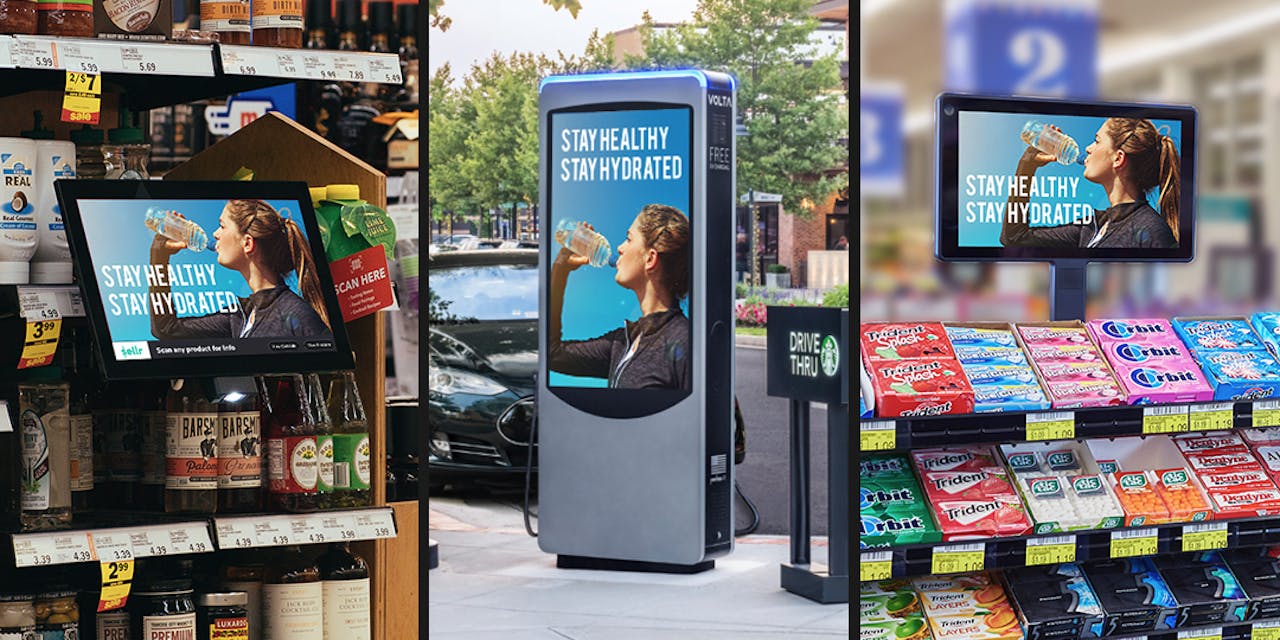Vistar Media
Vistar is the world's leading end-to-end programmatic ecosystem for digital out-of-home.
This promoted content is produced by a publishing partner of Open Mic. A paid-for membership product for partners of The Drum to self-publish their news, opinions and insights on thedrum.com - Find out more
Digital out-of-home: 3 media types advertisers should consider in 2023
January 19, 2023

When advertisers hear the phrase “digital out-of-home” (DOOH), they likely think of large billboards in notable locations like Times Square. While these boards will always be a cornerstone of DOOH advertising, the channel today offers so much more – allowing advertisers to truly get in front of consumers during multiple touch points throughout their day.
DOOH offers a variety of screen inventory for marketers to choose from – from large, high-impact signage to smaller, uniquely placed screens that offer 1:1 engagement. As brands and agencies evaluate how to make their 2023 media mix more efficient – and impactful – than ever, it’s important to take into account the true variety of DOOH. Let’s dive into how brands can tap into the full breadth of digital screens available today.
Advertisement
Large format: make a big, bold splash
Large format inventory means just that – vast, high-impact screens at locations like highways, bus shelters, urban panels, intersections, city centers and other high-traffic areas. Essentially, these real-world screens are so big they can’t not get your attention. A brand may gravitate toward this type of media when they’re looking to reach large groups of consumers while they’re on-the-go and aiming to drive upper funnel metrics like product and brand awareness.
The NBA, for example, executed an award-winning programmatic DOOH campaign in honor of its 75th Anniversary across a variety of high-impact digital screens. Their strategy included two takeovers in Times Square on key game days leading up to tipoff, driving audience engagement for the big game. The smart use of compelling large format canvases and eye-catching, personalized creatives ultimately drove a lift across all campaign KPIs, with the NBA Playoffs ranking first for awareness compared to all other major live sporting events happening at the same time.
Overall, large format DOOH screens command high viewability among mass audiences and allow for impactful creative messaging that is bound to elicit consumer engagement (and results).
Place-based: create a more tailored consumer experience
Yes, traditional billboards will always be a focal point of out-of-home (OOH) advertising given their impact and scale. However, a relatively newer type of DOOH media has emerged over the past decade and is one marketers have found exciting and valuable. Place-based media is a category of screens located in contextually relevant everyday environments, giving brands a unique opportunity to engage with consumers as they go about their day-to-day lives. These screens are often found in gas stations, taxis, bars, malls, gyms, restaurants, office buildings and other locations where consumers regularly spend time.
Perhaps you're a popular shoe retailer and want to promote your latest line of running shoes, so you activate media across a handful of gyms, malls and health food stores in multiple markets. Or, maybe you’re a credit card company and you decide to display ads for travel deals available through your credit card across airports, hotels and train stations. Place-based media equips brands with contextually relevant environments, so their ads actually reach and resonate with the right consumers.
One popular beauty retailer, for instance, leveraged place-based media by running DOOH ads across 10+ media networks representing a mix of venue types – from office buildings and gyms, to salons and malls. This approach allowed the brand to reach its target consumers in a variety of contextual environments during multiple touch points throughout their day, with the campaign driving a lift in all key metrics.
Point-of-purchase: influence purchasing decisions at key moments
While falling within the place-based media category, point-of-purchase media deserves its own moment, as it provides brands with a unique avenue for influencing purchase decisions while consumers are in-store and near the point of sale. Point-of-purchase media comprises screens within retail locations, such as grocery stores, pharmacies, convenience stores, liquor stores and big box stores, to name a few.
These eye-catching displays are strategically located throughout stores, such as along a wall of products consumers are shopping for or within the checkout aisle itself. Advertisers can leverage this type of DOOH signage to influence consumers while shopping is top-of-mind and the decision making window is relatively short. For instance, an up-and-coming liquor brand looking to boost brand awareness and sales of their latest collection may activate an ad with an exclusive discount in liquor store aisles and grocery store checkouts. Or, an allergy medicine company can take advantage of DOOH ads highlighting their products next to tissue boxes in pharmacies.
This Jägermeister campaign serves as an excellent example of the power of point-of-purchase advertising. The brand, who was looking to increase awareness, consideration and purchase intent for the Jägermeister brand itself and latest Cold Brew Coffee release, activated DOOH media across convenience stores, gas stations, liquor stores and grocery stores to reach consumers within a specific age group on their path to purchase and at their point of purchase. By strategically activating ads throughout their consumers’ journey, ensuring their brand and product remained top-of-mind, Jägermeister drove a significant lift in brand awareness, as well as a lift in consideration and purchase intent.
Getting started with these venue types today
From large format to place-based and point-of-purchase inventory, understanding the different digital screens that exist beyond billboards will only help set advertisers up for success in 2023. Not to mention, programmatic technology allows marketers to seamlessly – and quickly – buy DOOH placements across each of these unique venue types, making it easier than ever to activate across a mix of digital signage to achieve your goals.
Interested in learning how to tap into the full breadth of DOOH inventory available? Our team of experts at Vistar Media can answer any questions you have or provide a strategy consultation for your brand or client. Reach out today.


